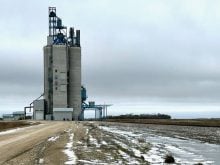Buckwheat is one of the few special crops that didn’t see higher seeded acreage this year.
The crop has nosedived since the early 1970s when Manitoba farmers were seeding 160,000 to 180,000 acres a year.
This year, farmers seeded about 28,000 acres, said Bruce Brolley, pulse crop specialist with Manitoba Agriculture.
That’s down from last year’s crop of about 34,000 acres, which was higher than usual due to expanded acreage in the flooded areas of the southwest.
But there’s hope that buckwheat acreage will rebound.
Read Also

Internet of Things tapped for better emissions insights
Interconnected field sensor fleet allows better soil monitoring coverage and, hopefully, live insights on farm greenhouse gas emissions and nitrogen fertilizer application for farms.
A research checkoff and new frost-tolerant varieties should bring more acres into production, said Brolley.
The Manitoba Buckwheat Growers Association mailed ballots recently for a vote on a voluntary checkoff.
It would be set at three-quarters of one percent of the value of production to a maximum of $250 per grower per year.
The $25,000 to $30,000 raised through the checkoff would go toward research and market development.
Some of the money would be spent on registering a new herbicide for broadleaf weed control.
Votes will be tallied in August.
Kade Research Ltd. of Morden, Man., developed the new frost-tolerant varieties, which will be grown in co-op trials next year and should be commercially available by 2002 or 2003.
The new varieties are earlier maturing and may offer growers some yield stability. They are also self-pollinating, whereas existing varieties rely on bees.
Brolley said Manitoba grows 60 to 75 percent of the Canadian buckwheat crop, with the remainder produced mostly in Ontario and Quebec.
The amount of buckwheat grown in the province fell dramatically in the 1980s when price premiums disappeared and farmers had yield problems due to hot, dry conditions.
Buckwheat acreage was replaced by new varieties of canola, wheat and flax.
Brolley said the price outlook for this year’s crop is stable.
“We’ve pretty much presold a lot of the crop already on a contract basis.”
Almost the entire prairie crop is exported to Japan where buckwheat flour is used to make soba noodles. The Japanese use high quality Canadian product to enhance lower quality buckwheat from China.
Older varieties like Manor and Mancan sell for about $5 per bushel for the first 10 bu. per acre.
Production over 10 bu. is spot-priced in the fall.
Contractors pay $7 per bu. for the full production on newer varieties like Koban and Koto, which produce the plump, black seeds that noodle makers desire.
Brolley said this year’s crop looks good, but the tale will be told in the fall.
If August is hot and dry, expect low yields.
The long-term average yield is about 18 bu. per acre, but that can drop as low as 10 bu. per acre under poor growing conditions.
Yields can reach 35 bu. per acre if everything is just right.
“We figure that they’ll put on a bushel per acre for every day that they are allowed to grow beyond say the third week in August,” said Brolley.
“Buckwheat is one of those crops that really benefits from as late a harvest date as possible.”
Manitoba Agriculture will be showcasing new buckwheat varieties and demonstrating its herbicide research during a summer tour Aug. 2 in Morden and Thornhill, Man.















